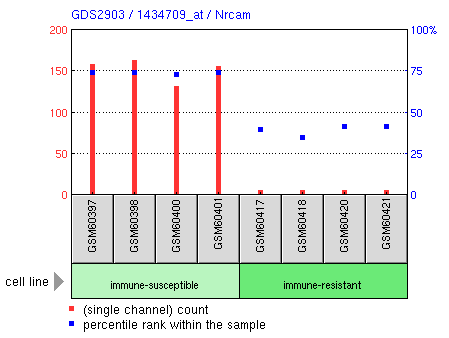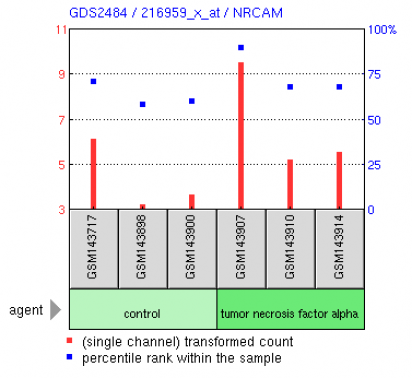Autism (NRCAM)
This web page was produced as an assignment for Gen677 at UW-Madison Spring 2009.
Human NrCAM gene sequence Homology Phylogeny Motifs
Homo sapiens neuronal cell adhesion molecule, transcript variant 1 (isoform A)
Gene length: 6659 bp
Accession number: NM_001037132
Homo sapiens NrCAM transcript variant 2 (isoform B)
Gene length: 6296 bp
Accession number: NM_005010.3
Homo sapiens NrCAM transcript variant 3 (isoform C)
Gene length: 2821 bp
Accession number: NM_001037133
The FASTA format for the NRCAM gene (isoforms A, B, and C) can be viewed below.
| human_nrcam_isoform_a.doc | |
| File Size: | 41 kb |
| File Type: | doc |
| human_nrcam_isoform_b.doc | |
| File Size: | 33 kb |
| File Type: | doc |
| human_nrcam_isoform_c.doc | |
| File Size: | 25 kb |
| File Type: | doc |
Gene expression data
Gene Expression Omnibus (GEO)
GEO allows you to search microarray data based on a variety of criteria. My searches did not return any NrCAM data sets providing heatmaps with microarray data to compare NrCAM expression to other genes of across various tissues using clustering techniques. Therefore, I selected a few examples of microarray data that were found by using NrCAM as the annotated gene. These examples are not in neuronal tissue so the relevance of the data to autism cannot really be commented on.
GEO allows you to search microarray data based on a variety of criteria. My searches did not return any NrCAM data sets providing heatmaps with microarray data to compare NrCAM expression to other genes of across various tissues using clustering techniques. Therefore, I selected a few examples of microarray data that were found by using NrCAM as the annotated gene. These examples are not in neuronal tissue so the relevance of the data to autism cannot really be commented on.
Highly immune-resistant cancer cell line expression GDS2903

Figure 1. Expression of NrCAM in a immune-resistant cancer cell line. This study was looking at the molecular mechanisms underlying tumor immune evasion. The immune-resistant cell line is produced by using multiple rounds of in vivo immune selection [1].
Dermal lymphatic endothelial cell response to TNF-alpha GDS2484

Figure 2. Expression of NrCAM in dermal lymphatic endothelial cells after treatment with tumor necrosis factor alpha. This study analyzed inflammation-induced changes following treatment with TNF-alpha. These experiments provided information about the mechanism involved in regulating the transmigration of leukocytes across the lymphatic vessel endothelium into the lymph nodes [2].
Analysis
The microarray data presented above shows definite differential expression of NrCAM between the immune-resistant cancer cell line and an immune-susceptible cell line. This is interesting due to the I-set and Ig domains present in NrCAM but it is difficult to make any conclusions about how these domains impact the immune evasion capabilities of cells. The increased NrCAM expression in immune-resistant cells indicates that NrCAM may prevent the immune system from recognizing the tumor cells as foreign and allow the tumor to evade the immune response. NrCAM expression is not as differential in the lymphatic endothelial cells treated with TNF-alpha or left untreated. Compared with the immune-resistant cell data, this indicates that the expression of NrCAM might be induced or repressed in response to different environmental or cell-cycle dependent conditions.
Though these data are not directly related to NrCAM's role in autism, they do provide evidence that NrCAM is differentially expressed in certain tissues treated with different conditions and maybe not in others. NrCAM expression studies in neural tissues would be an important to look at its role in autism. There has not been any experimental evidence to suggest that NrCAM is differentially expressed in nervous tissues of autistic individuals as compared to control nervous tissues. This would be an interesting study to conduct but it would require tissue samples which might be difficult to obtain. The studies could be conducted in rodent models where getting nervous tissue samples will not be as difficult.
Though these data are not directly related to NrCAM's role in autism, they do provide evidence that NrCAM is differentially expressed in certain tissues treated with different conditions and maybe not in others. NrCAM expression studies in neural tissues would be an important to look at its role in autism. There has not been any experimental evidence to suggest that NrCAM is differentially expressed in nervous tissues of autistic individuals as compared to control nervous tissues. This would be an interesting study to conduct but it would require tissue samples which might be difficult to obtain. The studies could be conducted in rodent models where getting nervous tissue samples will not be as difficult.
1. Lin KY, Lu D, Hung CF, Peng S. Ectopic expression of vascular cell adhesion molecule-1 as a new mechanism for tumor immune evasion. Cancer Res 2007 F1b 15;67(4):1832-41.
2. Johnson LA, Clasper S, Holt AP, Lalor PF. An inflammation-induced mechanism for leukocyte transmigration across lymphatic vessel endothelium. J Exp Med 2006 Nov 27;203(12):2763-77.
2. Johnson LA, Clasper S, Holt AP, Lalor PF. An inflammation-induced mechanism for leukocyte transmigration across lymphatic vessel endothelium. J Exp Med 2006 Nov 27;203(12):2763-77.
Brett Maricque
[email protected]
Last updated: 5/13/2009
http://www.gen677.weebly.com
